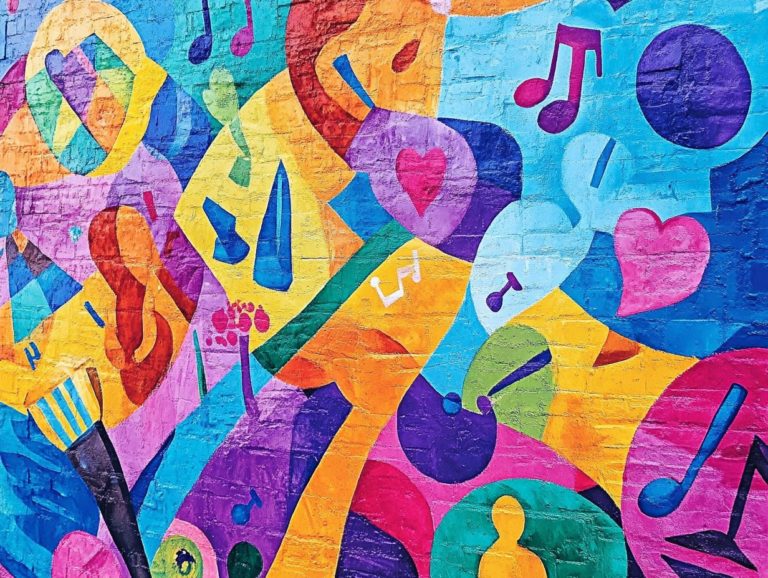how culture shapes language: a deep dive
Language and culture are closely connected, shaping and influencing one another in profound ways. By understanding this relationship, you gain valuable insights into how you communicate and connect with those around you.
This exploration delves into how culture impacts vocabulary, grammar, and communication styles, showcasing fascinating examples from diverse cultures. It also addresses the challenges of miscommunication that arise from cultural differences, emphasizing the importance of understanding and appreciating different cultures.
Dive into the rich tapestry of language through the lens of culture and discover the depth and nuance it brings to your interactions!
Contents
- Key Takeaways:
- The Relationship between Culture and Language
- Ways Culture Shapes Language
- Cultural Differences in Language
- Challenges of Language and Culture
- Miscommunication and Misunderstanding
- Unlock the Benefits of Cultural Understanding
- Frequently Asked Questions
- What is the relationship between culture and language?
- How does culture impact the development of language?
- Can culture impact the structure of language?
- How does culture affect the use of language?
- In what ways can culture influence the evolution of language?
- Are there any negative impacts of culture on language?
Key Takeaways:

Culture and language are closely connected. You can see this in how languages differ around the world. Culture shapes language through its impact on vocabulary, grammar, and communication styles. Understanding the connection between culture and language can lead to improved communication, promoting empathy and reducing misunderstandings.
The Relationship between Culture and Language
The relationship between culture and language invites you to explore how cultural norms profoundly shape your linguistic expressions and communication styles.
As you navigate the rich landscapes of ancient Egyptian culture, Japanese traditions, and contemporary linguistic practices, you’ll discover how language acquisition is influenced by shared cultural contexts and distinctive concepts.
This interplay between language and cultural identity sheds light on the cognitive processes that facilitate effective communication. It unveils the nuances of gestures, body language, and social hierarchy across diverse societies.
Defining Culture and Language
Culture embodies the shared values, beliefs, and norms of your group. Language acts as the primary vehicle for expressing and communicating these cultural elements.
The connection between culture and language becomes clear in the way certain phrases or idioms reflect how people live. For example, in many Indigenous cultures, language intertwines with spiritual beliefs, where the names of natural elements carry profound significance, reflecting a deep respect for nature.
In Japanese, the use of honorifics exemplifies the cultural norm of respect and hierarchy, shaping how individuals communicate across various contexts. In some cultures, the absence of a specific word for a concept may limit its expression or perception, highlighting how your society’s values influence communication practices.
Ways Culture Shapes Language
Culture profoundly influences every facet of language. It shapes vocabulary, grammar, and the subtle nuances of communication styles across diverse societies and languages.
The way people express themselves, their choice of words, and even their sentence structure are deeply intertwined with their cultural context, enriching the tapestry of human interaction.
Impact on Vocabulary
The impact of culture on vocabulary is clear in the unique cultural concepts and color terminology that characterize different languages, often lacking direct translations in others.
For example, the Japanese term ‘komorebi’ beautifully describes the sunlight filtering through leaves a concept that encapsulates a specific and evocative natural experience. Similarly, the Inuit language features many words for snow, each capturing a distinct quality or type, reflecting their deep connection with the environment.
These instances illustrate how vocabulary embodies cultural identities. However, when you attempt to translate these unique terms into another language, you may encounter challenges.
The richness of the original concept often becomes diluted, resulting in a translation that lacks the nuance and depth of its source.
Influence on Grammar and Syntax

Cultural factors greatly affect how you understand grammar and syntax, shaping the rules and structures that dictate sentence construction in various languages.
In languages like Japanese and Korean, the use of honorifics special words that show respect is essential, reflecting deep-rooted cultural norms and social hierarchies.
These languages also differentiate between formal and informal speech, which conveys respect and demonstrates awareness of your social standing in relation to the listener.
Such linguistic features highlight how culture prioritizes relationships and social context, resulting in grammatical structures that may seem foreign to you if you’re used to languages without similar hierarchical distinctions.
This connection between language and cultural values unveils the intricate ways societies shape their communication methods.
Effect on Communication Styles
Cultural context shapes your communication style in powerful ways, encompassing verbal and non-verbal elements like silence, gestures, and emotional cues.
Take Japan, for example; silence is revered as a crucial element of thoughtfulness and respect. This contrasts sharply with more expressive cultures, like those in the Mediterranean, where animated gestures and spirited verbal exchanges take center stage.
In non-verbal communication, a simple nod might indicate agreement in one culture, while in another, it could signify understanding without any commitment.
These nuances can profoundly impact how effectively your messages are conveyed and received. Understanding and respecting diverse communication styles is crucial when engaging in cross-cultural interactions.
Cultural Differences in Language
Cultural differences reveal themselves through a rich tapestry of languages and communication styles, showing how distinct cultural backgrounds shape language acquisition and comprehension.
Examples from Different Cultures
Examining examples from ancient Egyptian culture, Japanese culture, and Mandarin Chinese reveals a treasure trove of cultural insights and unique linguistic features.
For instance, ancient Egyptian hieroglyphs weren t just a writing system; they conveyed spiritual and ceremonial significance, showcasing the civilization’s deep connection to the afterlife.
In Japanese, the intricate layers of politeness and honorifics highlight societal respect and hierarchy, enhancing interpersonal relationships in a delicate dance of words.
Mandarin Chinese, with its tonal qualities, can convey different meanings, beautifully mirroring the cultural significance of nuance.
Understanding these linguistic nuances allows you to appreciate each culture’s identity and social norms on a deeper level. Dive deeper into how these differences affect your day-to-day communication!
Challenges of Language and Culture
The intersection of language and culture introduces numerous challenges, including miscommunication and translation dilemmas that may lead to misunderstandings.
Navigating this complex landscape requires a keen awareness of the nuances that shape interactions.
In summary, understanding the profound effects of culture on language helps enhance your communication skills and fosters better cross-cultural understanding.
Miscommunication and Misunderstanding

Miscommunication often stems from cultural differences and diverse communication styles. This can lead to misunderstandings that significantly impact your relationships.
When you meet people from different cultures, your own assumptions can sometimes cloud your understanding. For example, in some cultures, direct eye contact shows confidence, while in others, it may be seen as disrespectful. This divergence can create confusion during conversations.
Idiomatic expressions or humor that resonate well in your culture might not work the same way for someone from a different background. This can potentially cause offense.
To bridge these gaps, it s essential to practice empathy and nurture a curious mindset. Engaging in open dialogues about communication preferences and seeking clarification when uncertain can create an environment where cultural differences are acknowledged and respected.
Unlock the Benefits of Cultural Understanding
Grasping the link between culture and language presents a wealth of advantages. It leads to heightened cultural awareness, deeper empathy, and more effective communication skills.
This understanding enriches your interactions and broadens your perspective in meaningful ways.
Cultural Awareness and Empathy
Understanding different cultures is your gateway to engaging effectively. It s closely related to mastering languages and communicating empathetically.
This skill enables you to navigate complex social landscapes, whether in personal relationships or professional settings.
By understanding various cultural backgrounds, you can enhance your interactions and build stronger connections. Language mastery is key; it not only helps you convey information but also improves your listening skills.
When you speak the language of others, you often find common ground. This paves the way for genuine understanding and compassion.
Such empathy enriches your personal relationships and enhances teamwork in diverse workplaces. Embracing cultural awareness opens doors to deeper connections in every area of life.
Frequently Asked Questions
What is the relationship between culture and language?
Culture and language are closely intertwined. Culture shapes language by providing the context and values that influence its use. Conversely, language plays a key role in shaping culture by facilitating communication and expression within a cultural group.
How does culture impact the development of language?

Culture influences language development in many ways. It provides the context in which language is learned, including social norms and communication expectations.
Culture also dictates the important topics for a group, influencing their vocabulary and grammar.
Can culture impact the structure of language?
Yes, culture can indeed affect language structure. Different cultures organize and express ideas uniquely, resulting in variations in grammar and sentence structure.
For instance, some languages may have complex systems of verb tenses, while others may have simpler ones.
How does culture affect the use of language?
Culture significantly impacts language use. The beliefs, values, and customs of a culture can influence how language is used and understood.
Certain languages may have specific words or phrases used only in cultural contexts, or they might vary in formality depending on the setting.
Reflect on your experiences with cultural diversity. Embrace the journey of understanding and connection.
In what ways can culture influence the evolution of language?
Culture significantly influences how language evolves over time. As societies change, so do their languages.
New words and phrases develop to reflect changing norms and values. Words and phrases are often borrowed from other cultures, shaping language evolution.
Are there any negative impacts of culture on language?
Culture can also negatively affect language. For instance, some cultural beliefs can lead to the discrimination of certain languages or dialects.
This discrimination can cause a loss of linguistic diversity and limit how some cultural groups express themselves.





